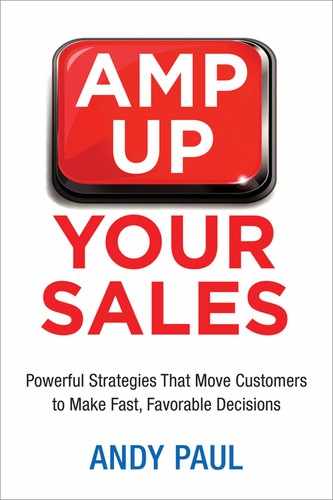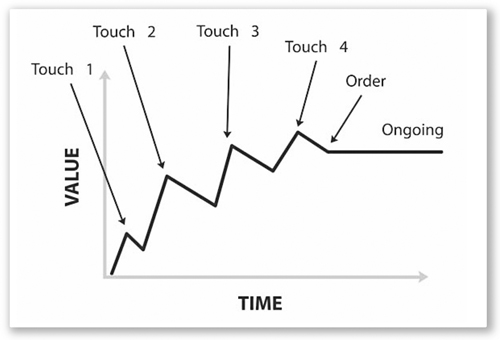CHAPTER 16
The Peak/End Rule of Sales
It’s time to add a little more science to your selling. You’ve probably noticed that I have referred to various scientific studies and surveys throughout this book. My objective is to help you understand the logic and science behind how buying and selling work. At the same time, I want to challenge you to think differently about how selling and buying fit together and about how you should integrate this new knowledge into your own sales efforts—especially in how you plan and execute your sales strategies with your customers.
Now for something that will really transform how you think about your selling process.
Daniel Kahneman is a Nobel Prize–winning economist who is famous for his work on decision making and behavioral economics. Through his research on how people make decisions, Kahneman developed what he called the Peak/End rule. In The Paradox of Choice, Swarthmore College Professor Barry Schwarz presented a succinct description of the Peak/End Rule: “Kahneman showed that what we remember about the quality of our past experiences, both good and bad, was almost entirely determined by how the experiences felt when they were at their peak (best or worst) and how they felt when they ended. We use the peak-end rule to summarize the experience and to remind ourselves how the experience felt.”
In a paper from 1999, Kahneman describes one study in which participants in a laboratory were asked to listen through headphones to what he described as “a pair of intensely unpleasant noises.” The first noise was 10 seconds long at 78 decibels (approximately the volume of a garbage disposal). The second noise was the same 10 seconds also at 78 decibels, followed by four seconds at 66 decibels (roughly the volume of a vacuum cleaner). When presented the chance to choose which of the two noises to listen to again, the overwhelming majority of the participants chose the longer one. On the surface, that choice would appear to be counterintuitive. But in the first noise, the peak experience and the end experience were the same: a loud, annoying noise. The end experience of listening to the second noise was less unpleasant than the end experience of the first noise, so that’s what the participants chose. As Kahneman summarized, “People choose to repeat the sound they dislike least, and the Peak/End rule determines that.”
The implications of this are very exciting for salespeople who are serious about amping up their selling. Do you see the value that the Peak/End rule provides? In selling, it means that when your customers arrive at the conclusion of their buying cycles and are summarizing their experiences with the various sellers competing for their business, their feelings about you (your product and your company) will be “almost entirely determined” by the peak experience (good or bad) that you created for them during their buying process and by the most recent experience the customer had with you.
This finding is consistent with everything we know about customers in today’s business and consumer environments. They are extremely busy and short on time. They are pressed to make better decisions faster. Meaningful differences between products shrink as more suppliers enter the market in every product category. And every seller looks the same.
When the time arrives to make a decision, customers will consider all the tangible factors that might distinguish your offering from those of your competitors. But mostly, they will recall the peak experience from the selling process and their most recent interaction with you. And they’ll use that as a basis for her deciding whether they want to buy from you. After all, if the peak experience of working with you during the buying process was negative, then customers will likely not choose to repeat it.
Remember how in Chapter 1 I told you that your success in sales will be determined more by how you sell than what you sell? The Peak/End rule proves it. You have the imperative to take deliberate sales actions that will create the peak experiences that make your selling memorable to the customer.
Figure 16-1 shows the ordinary sales process again. It’s hard to see where the peak experience is for the buyer. In the graph, the seller is just going through the motions, doing what he thinks needs to be done but not thinking about what the customer needs.
In this next graph (Figure 16-2), we have the Maximum Value sales process laid over the standard sales process. Suddenly it starts to make some sense, right? Each of the customer touches on the upper Maximum Value track represent potential peak events in the customer’s buying process. The Value Gap is created by a maximum value sales touch. In other words, at that stage in the customer’s buying process, the incremental value you delivered compared to the competitor’s would potentially be a peak event.
I am often asked two questions about this: “How can you know in advance which touch will be the peak event? And how do you plan for it if you don’t know that?” The short answer to both questions is the same: You can’t. Every customer touch has the potential to be the peak experience. Therefore, you should plan and execute each and every sales interaction, no matter how big or small, as if it will be the peak experience for the customer.
Take a seemingly innocuous sales action such as a sales lead follow-up. It happens right at the beginning of your sales process. Everyone does it. Or do they? Various studies have found that anywhere from 40 to 70 percent of sales leads are not followed up. So the very act of responsively following up has the potential to be surprising and memorable to your prospective customers.
Look at Figure 16-2 again. On the upper Maximum Value track, the sales rep followed up faster than the rep on the lower Standard track. She quickly researched the company before calling to learn about the business and potential challenges it may face. She also checked through the LinkedIn profile of the requestor to check his or her job title and determine whether they had shared connections. She may have provided value during the call, but she almost certainly created value by being immediately responsive. On the Standard track, the sales rep didn’t prioritize the follow-up. He did little prep work, and when he made the follow-up call, he wasn’t prepared to focus on the customer and defaulted to talking about his own company, not the customer’s.
Michael is an acquaintance who is a VP at a tech company that was undergoing an intense growth spurt and was hiring a lot of people. At one point they were inundated with unsolicited resumes that job seekers were submitting online. The executive management team decided to invest in a cloud-based system to track the resumes and applicants. Tasked with investigating potential solutions, Michael invested a Saturday of his own time to research the available software options. After four hours of research, he had it narrowed down to three companies. Using the Contact Us form on each of the companies’ websites, he entered his name and title and wrote a detailed message to explain his requirements, reinforce the urgency of his situation, and request a call by a salesperson ASAP. A full business week passed before he received the first response from any of the three vendors.
That salesperson seemed a little confused when Michael informed him that they were going to stick with their current system for the time being. Hadn’t Michael just sent his company an e-mail stating that he urgently needed their solution? Michael agreed that he had. But he said that if it required the better part of a week just to respond to his urgent sales lead, then he couldn’t imagine how long it would take them to respond to a customer service request once his company had purchased their system. He didn’t need that headache. Instead, he figured out a way to cope with the volume of resumes they were receiving with their existing manual system. Six months later, Michael’s company invested in a solution to manage and track applicants. None of the three vendors he had originally contacted were given the chance to bid on his business a second time.
Had a salesperson from any of the three companies that Michael originally contacted followed up with him with the first 24 hours, it would have been a peak experience that Michael would have remembered at decision-making time. As it was, when the first sales rep finally followed up nearly a week after the contact request was submitted, it became a peak event in the negative sense.
Always remember the Peak/End rule of selling, and don’t let it work against you.


